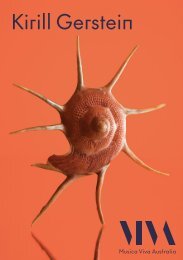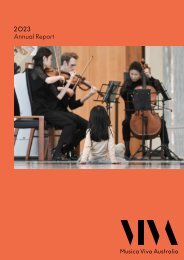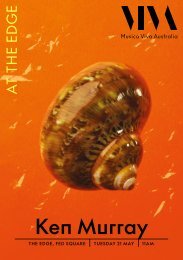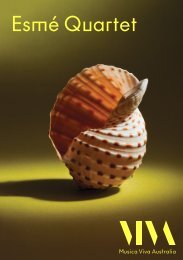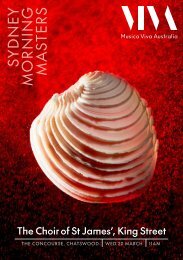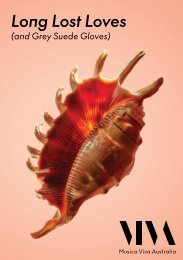Create successful ePaper yourself
Turn your PDF publications into a flip-book with our unique Google optimized e-Paper software.
in Rome but this was an important time for<br />
the composer in gaining confidence with his<br />
emerging unique musical voice. He had also<br />
recently discovered the music of Wagner and<br />
heard for the first time Javanese Gamelan,<br />
and both experiences were to influence his<br />
compositional development.<br />
In his Two Poems, Scriabin moves away from<br />
the Romantic gestures of the studies, creating a<br />
more forward-looking exploration of melody,<br />
texture and harmony which would evolve into<br />
his mature style. Also around this time, we see<br />
the development of his aesthetic to embrace a<br />
mystical, transcendental conception of music.<br />
While the first Poem is languid, rhythmically<br />
fluid and melodically focused, the second is<br />
an explosive, rhythmically driven piece full of<br />
extrovert energy.<br />
The Piano Sonata No. 5, written four years<br />
later, takes these extreme moods even further.<br />
This is an intensely volatile piece, languid and<br />
dreamy one moment, then suddenly frenzied<br />
and excited. Scriabin often juxtaposes these<br />
states without preparation, resulting in a form<br />
that feels episodic rather than organic but<br />
never ceases to surprise and excite.<br />
ANNOTATIONS BY MARK COUGHLAN © <strong>2023</strong><br />
Debussy began writing the Suite bergamasque<br />
around 1890 although it was not until 1905<br />
that it was revised and published. The work<br />
pays homage in part to the Baroque keyboard<br />
music that Debussy greatly admired, especially<br />
that of Couperin. The opening Prélude has an<br />
improvisatory quality alternating between<br />
bold and elegant. The following Menuet<br />
has a slightly wistful character, playful and<br />
delicate, its vigorous dance rhythms somewhat<br />
restrained. Clair de lune is a work of ethereal<br />
beauty and one of the most celebrated of all<br />
piano pieces with its ravishing textures and<br />
seductive harmonies. The final Passepied<br />
bubbles along to the gently driving left-hand<br />
rhythm, drawing this charming set to a close.<br />
<strong>Program</strong> 2<br />
In the late 1880s Claude Debussy returned to<br />
Paris having spent a couple of unfulfilling years<br />
at the Villa Medici in Rome, a residency that<br />
resulted from his winning the prestigious Prix<br />
de Rome in 1884. He was disappointed with the<br />
company, the food and the accommodation<br />
Samuel Barber is regarded as one of<br />
America’s finest composers. Born in 1910 into<br />
a musical family, he studied composition,<br />
voice and piano and for a number of years<br />
was a student at the celebrated Curtis Institute<br />
in Philadelphia. He decided early on that<br />
music would be his chosen career, writing to<br />
his mother at the age of nine to declare his<br />
intention to become a composer and asking<br />
her not to force him to play football. By the age<br />
of seven he had written his first piano piece,<br />
08










